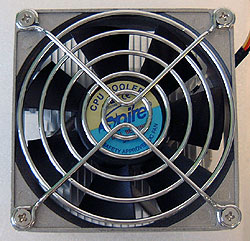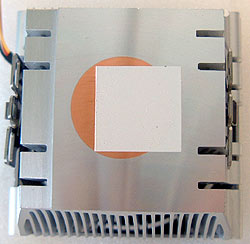| Spire 5F271B1L3 Heatsink
From All Angles |
 |
The Fan:
Rotating at just 2300RPM, the 80mm fan you see on
top of the FalconRock II is equipped with a cast aluminum frame, and plastic impeller.
Why aluminum was chosen is beyond me - there is no benefit to using
that material for the fan casing except for added durability.
The fan grill is a useful addition and protects the
large intake from errant wires and power connectors. The fan draws power from
a three-pin motherboard fan header.
|
 |
Heatsink Top:
A single slice is cut through the center of
the heatsink for the fan clip. There are four additional, smaller
cuts to help with exhaust air escaping from the heatsink. Oddly, the peak in
the center of the heatsink does not correspond with the location the
heatsink mounts onto the processor core. A small spring retainer keeps the clip
from floating up and out of the heatsink. |
 |
Side A:
An aluminum fan
mounted to an aluminum heatsink is pretty unique. The large screws hold
the fan firmly in place, and
since it rotates at
a relatively low RPM there isn't much noise at all. The fan is suspended
a few millimeters above the tips of the fins to promote better airflow. The base is
6mm thick at the edges, and rises to 13mm thick at the center. The
fins of the heatsink are 1mm thick and spaced 2mm
apart. |
 |
Side B:
The upper portion of the Spire 5F271B1L3 measures 80mm in
size, but to fit on the motherboard the manufacturer has
had to squeeze the base down to 60mm is size. To do achieve
this the base tapers in, and the fins are cut in a curved
fashion. This makes the FalconRock II compatible with even the most crowded motherboard out there.
The outside scalping of the fins is more for gripping than it is for
any one thermal advantage. |
 |
Heatsink Base:
The base is excellently finished and machined perfectly flat. The small 30mm diameter
copper disc is set into the base nicely, but we have no
data on how thick the copper actually is. A small patch of
white silicon thermal compound comes pre-applied to the base which means installation
is a snap. Curiously, the copper is centered on the heatsink instead
of being centered around where the processor will actually make contact with
the metal. |


